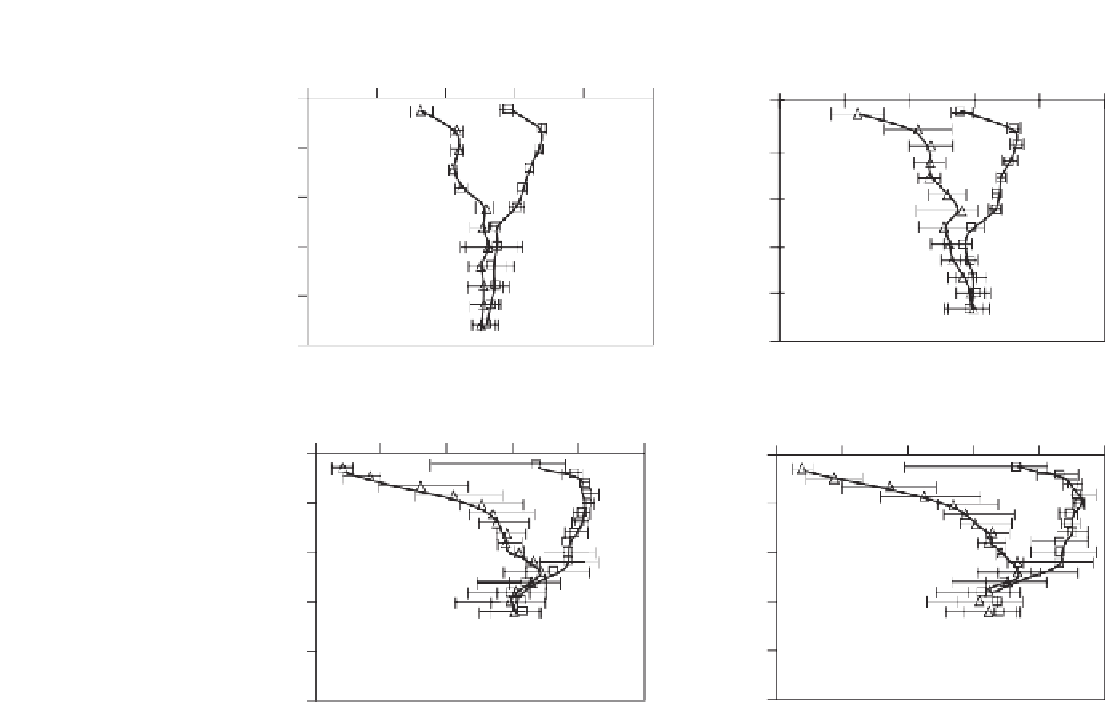Environmental Engineering Reference
In-Depth Information
Water content (m
3
m
−
3
)
Water content (m
3
m
−
3
)
0
0.1
0.2
0.3
0.4
0.5
0
0.1
0.2
0.3
0.4
0.5
0
0
50
50
100
100
150
150
200
200
Neutron
Trime T3
250
250
Water content (m
3
m
−
3
)
Water content (m
3
m
−
3
)
0
0.1
0.2
0.3
0.4
0.5
0
0.1
0.2
0.3
0.4
0.5
0
0
50
50
100
100
150
150
200
200
EnviroSCAN
Diviner2000
250
250
Figure 4.96
Soil-water contents measured using several different measurement sensors (from
Training Course No. 30, IAEA, 2008).
influenced by hydrostatic pressure conditions if the water
table is within a few meters of the ground surface. If it is
assumed that the net infiltration at the ground surface is zero
(i.e., precipitation is approximately equal to actual evapora-
tion over each year), then the matric suction profile will be
controlled by the hydrostatic pore-water pressure line.
The depth to the water table and the hydrostatic pore-water
pressure line provide an indication of the matric suction
values to likely be encountered. Figure 4.97 illustrates the
hydrostatic line corresponding to a water table at various
depths below ground surface. The hydrostatic line is an
equilibrium pressure line corresponding to either no net infil-
tration at ground surface or nearly equal inflow and outflow
of moisture at the ground surface.
Excessive infiltration of water at the ground surface will
tend to reduce the matric suction at ground surface. Dur-
ing a rainstorm water may temporarily accumulate on the
ground surface, reducing the matric suction to zero. The
infiltration of water at the ground surface will also affect the
underlying matric suction profile. In other words, the matric
suction profile can be thought of as being strongly influ-
enced by the water table and the ground surface boundary
conditions. Conversely, excessive evaporation of water from
the ground surface can result in a drying of the soil at the
ground surface with the result that the near-ground-surface
matric suction increases beyond what would be anticipated
based on hydrostatic conditions.
4.6.2 Use of SWCC to Estimate Soil Suction
The SWCCs are used extensively for the estimation of unsat-
urated soil property functions (Fredlund, 1995b; 2000a), and
have been pivotal to the implementation of unsaturated soil
mechanics into geotechnical engineering practice. Estima-
tion procedures for unsaturated soil property functions have
been proposed for virtually every physical process involving
unsaturated soils (Fredlund et al., 1997b; Fredlund, 2006b).
Engineers have desired to use SWCCs as a means to esti-
mate in situ soil suctions, but their usage for this purpose has
been discouraged (Fredlund et al., 2001b). SWCCs can be
used for the estimation of in situ suction but the user needs
to understand (i) the level of accuracy associated with using
the SWCC and (ii) the likely range of soil suction values
associated with a measured natural water content of the soil.
The use of SWCCs to estimate in situ soil suction must
take into consideration hysteresis associated with the dry-
ing (desorption) and wetting (adsorption) curves. Gener-
ally the drying curve is measured in the laboratory. The
asymptotic nature of most empirical equations used to rep-
resent the SWCC makes it possible to only estimate soil









Search WWH ::

Custom Search